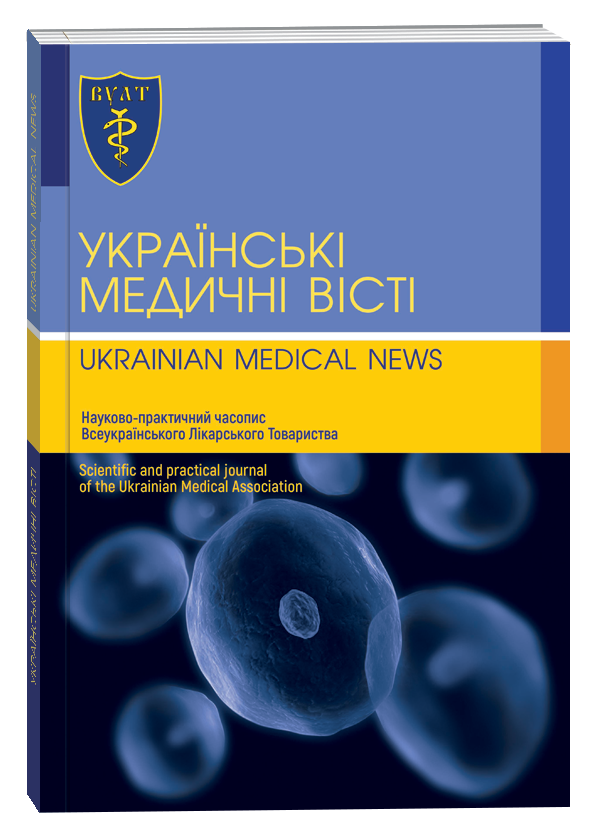ТЕЛМІСАРТАН У СВІТЛІ НОВІТНІХ КЛІНІЧНИХ ДОСЛІДЖЕНЬ: ЕФЕКТИВНІСТЬ ТА ПЕРСПЕКТИВИ ВИКОРИСТАННЯ
DOI:
https://doi.org/10.32782/umv-2025.1.16Ключові слова:
телмісартан, артеріальна гіпертензія, цукровий діабет, ожирінняАнотація
Телмісартан, що належить до групи блокаторів рецепторів ангіотензину II (БРА), є високоефективним препаратом для лікування артеріальної гіпертензії як у монотерапії, так і в комбінації. Його унікальність полягає у найдовшому періоді напіввиведення серед БРА, що забезпечує стабільний і тривалий контроль артеріального тиску протягом доби. Крім основної дії, телмісартан чинить частковий агоністичний вплив на рецептори PPARγ. На відміну від повних агоністів PPARγ (тіазолідиндіонів), телмісартан покращує метаболічні показники, не викликаючи при цьому небажаних побічних ефектів. Телмісартан – потужний антагоніст рецепторів ангіотензину II типу 1, що є ключовим у регуляції судинного тонусу, продукції альдостерону та симпатичного нервового тонусу. Часткова агоністична активність щодо PPARγ надає йому протизапальні, антипроліферативні й антиоксидантні властивості, що робить його цінним для лікування пацієнтів із метаболічними порушеннями, цукровим діабетом, атеросклерозом і серцево-судинними ускладненнями. Особлива увага приділяється потенціалу телмісартану в онкології. Препарат може виявляти антипроліферативні, антиапоптотичні й антиметастатичні ефекти, що може стати основою для майбутніх клінічних випробувань із перепрофілювання препарату як потенційного протиракового агента.Багатогранні фармакологічні властивості телмісартану – від антигіпертензивних та метаболічних до протизапальних, кардіо-, нефро-, нейро- та протиракових – роблять його перспективним засобом для лікування широкого спектра захворювань. Поєднання цих ефектів робить його особливо цінним для пацієнтів із поєднаною серцево-судинною та метаболічною патологією, а також відкриває нові можливості для його терапевтичного застосування поза межами класичної кардіології.
Посилання
1. Takimoto-Ohnishi E, Murakami K. Renin–angiotensin system research: from molecules to the whole body. J Physiol Sci [Internet]. 2019 Jul 26;69(4):581–7. Available from: https://doi.org/10.1007/s12576-019-00679-4.
2. Patel S, Rauf A, Khan H, Abu-Izneid T. Renin-angiotensin-aldosterone (RAAS): The ubiquitous system for homeostasis and pathologies. Biomed Pharmacother. 2017 Oct 1;94:317–25.
3. Su C, Xue J, Ye C, Chen A. Role of the central renin - angiotensin system in hypertension ( Review ). 2021;1–16.
4. Poznyak A V, Bharadwaj D, Prasad G, Grechko A V, Sazonova MA, Orekhov AN. Renin-Angiotensin System in Pathogenesis of Atherosclerosis and Treatment of CVD. Int J Mol Sci 2021. 2021;22.
5. Katsimardou A, Imprialos K, Stavropoulos K, Sachinidis A, Doumas M, Athyros V. Hypertension in Metabolic Syndrome : Novel Insights. 2019;1–7.
6. Chen H, Li M, Liu L, Zhu D, Tian G. Telmisartan improves myocardial remodeling by inhibiting leptin autocrine activity and activating PPARγ. Exp Biol Med. 2020;245(7):654–66.
7. Botta M, Audano M, Sahebkar A, Sirtori CR, Mitro N, Ruscica M. PPAR agonists and metabolic syndrome: An established role? Int J Mol Sci. 2018;19(4).
8. Suksomboon N, Poolsup N, Prasit T. Systematic review of the effect of telmisartan on insulin sensitivity in hypertensive patients with insulin resistance or diabetes. Vol. 37, Journal of Clinical Pharmacy and Therapeutics. 2012. p. 319–27.
9. Kiyici S, Guclu M, Budak F, Sigirli D, Tuncel E. Even Short-Term Telmisartan Treatment Ameliorated Insulin Resistance But Had No Influence on Serum Adiponectin and Tumor Necrosis Factor-Alpha Levels in Hypertensive Patients with Metabolic Syndrome. Metab Syndr Relat Disord [Internet]. 2019 Apr 1 [cited 2021 Jun 25];17(3):167–72. Available from: https://pubmed.ncbi.nlm.nih.gov/30688550/.
10. Wang Y, Xue J, Li Y, Zhou X, Qiao S, Han D. Telmisartan protects against high glucose/high lipid-induced apoptosis and insulin secretion by reducing the oxidative and ER stress. Cell Biochem Funct. 2019;37(3):161–8.
11. Jackson L, Eldahshan W, Fagan S, Ergul A. Within the Brain: The Renin Angiotensin System. Int J Mol Sci [Internet]. 2018 Mar 15;19(3):876. Available from: www.mdpi.com/journal/ijms.
12. Su C, Xue J, Ye C, Chen A. Role of the central renin - angiotensin system in hypertension (Review). 2021;1–16.
13. Rawish E, Nickel L, Schuster F, Stölting I, Frydrychowicz A, Saar K, et al. Telmisartan prevents development of obesity and normalizes hypothalamic lipid droplets. J Endocrinol [Internet]. 2020;244:95–110. Available from: https://doi.org/10.1530/JOE-19-0319.
14. Wang Y, Xue J, Li Y, Zhou X, Qiao S, Han D. Telmisartan protects against high glucose/high lipid-induced apoptosis and insulin secretion by reducing the oxidative and ER stress. Cell Biochem Funct. 2019;37(3):161–8.
15. Chen H, Li M, Liu L, Zhu D, Tian G. Telmisartan improves myocardial remodeling by inhibiting leptin autocrine activity and activating PPARγ. Exp Biol Med. 2020;245(7):654–66.
16. 16Galzerano, D., Capogrosso, C., Di Michele, S., Galzerano, A., Paparello, P., Lama, D., & Gaudio, C. (2010). New standards in hypertension and cardiovascular risk management: focus on telmisartan. Vascular health and risk management, 113–133.
17. T. Ebner, G. Heinzel, A. Prox, K. Beschke, H. Wachsmuth Disposition and chemical stability of telmisartan 1-O-acylglucuronide Drug Metab. Dispos., 27 (10) (1999), pp. 1143–1149.
18. M.A. Ayza, K.A. Zewdie, B.A. Tesfaye, S.T. Gebrekirstos, D.F. Berhe Anti-diabetic effect of telmisartan through its partial PPARγ-agonistic activity Diabetes Metab. Syndr. Obes., 13 (2020), pp. 3627–3635.
19. H.A. Pershadsingh, T.W. Kurtz, Insulin-sensitizing effects of telmisartan: implications for treating insulin- resistant hypertension and cardiovascular disease, Diabetes Care 27 (4) (2004) 1015.
20. C.J. Tack, P. Smits, Thiazolidinedione derivatives in type 2 diabetes mellitus,Neth. J. Med 64 (6) (2006) 166–174.
21. W.T. Wong, X.Y. Tian, A. Xu, J. Yu, C.W. Lau, R.L. Hoo, et al., Adiponectin isrequired for PPARγ-mediated improvement of endothelial function in diabetic mice, Cell Metab. 14 (1) (2011) 104–115.
22. Imenshahidi, M., Roohbakhsh, A., & Hosseinzadeh, H. (2024). Effects of telmisartan on metabolic syndrome components: a comprehensive review. Biomedicine & Pharmacotherapy, 171, 116169.
23. P. Balakumar, S. Kathuria, Submaximal PPARγ activation and endothelial dysfunction: new perspectives for the management of cardiovascular disorders, Br. J. Pharmacol. 166 (7) (2012) 1981–1992.
24. G. Wang, J. Wei, Y. Guan, N. Jin, J. Mao, X. Wang, Peroxisome proliferator-activated receptor-gamma agonist rosiglitazone reduces clinical inflammatory responses in type 2 diabetes with coronary artery disease after coronary angioplasty, Metabolism 54 (5) (2005) 590–597.
25. J.G. Wang, E. Pimenta, F. Chwallek, Comparative review of the blood pressure-lowering and cardiovascular benefits of telmisartan and perindopril, Vasc. Health Risk Manag. 10 (2014) 189–200.
26. M.V. Liberato, A.S. Nascimento, S.D. Ayers, J.Z. Lin, A. Cvoro, R.L. Silveira, et al., Medium chain fatty acids are selective peroxisome proliferator activated receptor (PPAR) γ activators and pan-PPAR partial agonists, PLoS One 7 (5) (2012) e36297.
27. P. Chinnam, M. Mohsin, L.M. Shafee, Evaluation of acute toxicity of pioglitazone in mice, Toxicol. Int. 19 (3) (2012) 250–254.
28. C.H. Chang, L.A. McNamara, M.S. Wu, E.S. Muise, Y. Tan, H.B. Wood, et al., A novel selective peroxisome proliferator-activator receptor-gamma modulator-SPPARgammaM5 improves insulin sensitivity with diminished adverse cardiovascular effects, Eur. J. Pharmacol. 584 (1) (2008) 192–201.
29. K. Henriksen, I. Byrjalsen, P. Qvist, H. Beck-Nielsen, G. Hansen, B.J. Riis, et al., Efficacy and safety of the PPARγ partial agonist balaglitazone compared with pioglitazone and placebo: a phase III, randomized, parallel-group study in patients with type 2 diabetes on stable insulin therapy, Diabetes Metab. Res. Rev. 27 (4) (2011) 392–401.
30. J. Zhang, X. Liu, X.B. Xie, X.C. Cheng, R.L. Wang, Multitargeted bioactive ligands for PPARs discovered in the last decade, Chem. Biol. Drug Des. 88 (5) (2016) 635–663.
31. T. Haraguchi, K. Iwasaki, K. Takasaki, K. Uchida, T. Naito, A. Nogami, et al., Telmisartan, a partial agonist of peroxisome proliferator-activated receptor gamma, improves impairment of spatial memory and hippocampal apoptosis in rats treated with repeated cerebral ischemia, Brain Res. 1353 (2010) 125–132.
32. Y. Amano, T. Yamaguchi, K. Ohno, T. Niimi, M. Orita, H. Sakashita, et al., Structural basis for telmisartan- mediated partial activation of PPAR gamma, Hypertens. Res. 35 (7) (2012) 715–719.
33. K. Kappert, O. Tsuprykov, J. Kaufmann, J. Fritzsche, I. Ott, M. Goebel, et al. Chronic treatment with losartan results in sufficient serum levels of the metabolite EXP3179 for PPARgamma activation, Hypertension 54 (4) (2009) 738–743.
34. T.G. Marshall, R.E. Lee, F.E. Marshall, Common angiotensin receptor blockers may directly modulate the immune system via VDR, PPAR and CCR2b, Theor. Biol. Med. Model. 3 (1) (2006).
35. V. Zídek, P. Mlejnek, M. Sim´akov´a, J. Silhavy, V. Landa, L. Kazdov´a, et al., Tissue-specific peroxisome proliferator activated receptor gamma expression and metabolic effects of telmisartan, Am. J. Hypertens. 26 (6) (2013) 829–835.
36. R. Clasen, M. Schupp, A. Foryst-Ludwig, C. Sprang, M. Clemenz, M. Krikov, et al., PPARgamma-activating angiotensin type-1 receptor blockers induce adiponectin, Hypertension 46 (1) (2005) 137–143.
37. L.J. Min, M. Mogi, M. Shudou, F. Jing, K. Tsukuda, K. Ohshima, et al., Peroxisome proliferator-activated receptor-γ activation with angiotensin II type 1 receptor blockade is pivotal for the prevention of blood-brain barrier impairment and cognitive decline in type 2 diabetic mice, Hypertension 59 (5) (2012) 1079–1088.
38. K. Ushijima, M. Takuma, H. Ando, E. Ishikawa-Kobayashi, M. Nozawa, T. Maekawa, et al., Effects of telmisartan and valsartan on insulin sensitivity in obese diabetic mice, Eur. J. Pharmacol. 698 (1-3) (2013) 505–510.
39. W.Q. Chen, Y. Shu, Q. Li, L.Y. Xu, M.W. Roederer, L. Fan, et al., Polymorphism of ORM1 is associated with the pharmacokinetics of telmisartan, PLoS One 8 (8)(2013) e70341.
40. P. Hirvensalo, A. Tornio, T. Launiainen, M. Paile-Hyv¨arinen, T. Tapaninen,M. Neuvonen, et al., UGT1A3 and sex are major determinants of telmisartan pharmacokinetics-a comprehensive pharmacogenomic study, Clin. Pharm. Ther. 108 (4) (2020) 885–895.
41. Z.H. Israili, Clinical pharmacokinetics of angiotensin II (AT1) receptor blockers in hypertension, J. Hum. Hypertens. 14 (Suppl 1) (2000) S73–S86.
42. Ma H, Jiang H, Feng J, Gan Y. Angiotensin Receptor Blocker and Calcium Channel Blocker Preventing Atrial Fibrillation Recurrence in Patients with Hypertension and Atrial Fibrillation: A Meta-analysis [Internet]. Vol. 2021, Cardiovascular Therapeutics. 2021. Available from: https://doi.org/10.1155/2021/6628469.
43. Kiyici S, Guclu M, Budak F, Sigirli D, Tuncel E. Even Short-Term Telmisartan Treatment Ameliorated Insulin Resistance But Had No Influence on Serum Adiponectin and Tumor Necrosis Factor-Alpha Levels in Hypertensive Patients with Metabolic Syndrome. Metab Syndr Relat Disord [Internet]. 2019 Apr 1 [cited 2021 Jun 25];17(3):167–72. Available from: https://pubmed.ncbi.nlm.nih.gov/30688550/.
44. Hadjiyianni, A., & Kalali, D. (2023). The potential anticancer activities of telmisartan–a literature review. In Annales Academiae Medicae Silesiensis (No. 77). Śląski Uniwersytet Medyczny w Katowicach.
45. Xie, M., Tang, T., & Liang, H. (2023). Efficacy of single‐pill combination in uncontrolled essential hypertension: A systematic review and network meta‐analysis. Clinical Cardiology, 46 (8), 886–898.
46. S. Tatami, N. Yamamura, A. Sarashina, C.L. Yong, T. Igarashi, Y. Tanigawara, Pharmacokinetic comparison of an angiotensin II receptor antagonist, telmisartan, in Japanese and western hypertensive patients using population pharmacokinetic method, Drug Metab. Pharmacokinet. 19 (1) (2004) 15–23.
47. S. Haenisch, U. Zimmermann, E. Dazert, C.J. Wruck, P. Dazert, W. Siegmund, et al., Influence of polymorphisms of ABCB1 and ABCC2 on mRNA and protein expression in normal and cancerous kidney cortex, Pharm. J. 7 (1) (2007) 56–65.
48. S. Choudhuri, C.D. Klaassen, Structure, function, expression, genomic organization, and single nucleotide polymorphisms of human ABCB1 (MDR1),ABCC (MRP), and ABCG2 (BCRP) efflux transporters, Int J. Toxicol. 25 (4) (2006) 231–259.
49. M. Naesens, D.R. Kuypers, K. Verbeke, Y. Vanrenterghem, Multidrug resistance protein 2 genetic polymorphisms influence mycophenolic acid exposure in renal allograft recipients, Transplantation 82 (8) (2006) 1074–1084.
50. F.A. de Jong, T.J. Scott-Horton, D.L. Kroetz, H.L. McLeod, L.E. Friberg, R.H. Mathijssen, et al., Irinotecan- induced diarrhea: functional significance of the polymorphic ABCC2 transporter protein, Clin. Pharm. Ther. 81 (1) (2007) 42–49.
51. A.H. Schinkel, J.W. Jonker, Mammalian drug efflux transporters of the ATP binding cassette (ABC) family: an overview, Adv. Drug Deliv. Rev. 55 (1) (2003) 3–29.
52. N. Ishiguro, K. Maeda, W. Kishimoto, A. Saito, A. Harada, T. Ebner, et al., Predominant contribution of OATP1B3 to the hepatic uptake of telmisartan, an angiotensin II receptor antagonist, in humans, Drug Metab. Dispos. 34 (7) (2006) 1109–1115.
53. J. Weiss, A. Sauer, N. Divac, M. Herzog, E. Schwedhelm, R.H. B¨oger, et al., Interaction of angiotensin receptor type 1 blockers with ATP-binding cassette transporters, Biopharm. Drug Dispos. 31 (2-3) (2010) 150–161.
54. A. Yamada, K. Maeda, N. Ishiguro, Y. Tsuda, T. Igarashi, T. Ebner, et al., The impact of pharmacogenetics of metabolic enzymes and transporters on the pharmacokinetics of telmisartan in healthy volunteers, Pharm. Genom. 21 (9) (2011) 523–530.
55. T. Imre, G. Schlosser, G. Pocsfalvi, R. Siciliano, E. Moln´ar-Sz¨ollosi, T. Kremmer, et al., Glycosylation site analysis of human alpha-1-acid glycoprotein (AGP) by capillary liquid chromatography-electrospray mass spectrometry, J. Mass Spectrom. 40 (11) (2005) 1472–1483.
56. D.F. Blackburn, T.W. Wilson, Antihypertensive medications and blood sugar: theories and implications, Can. J. Cardiol. 22 (3) (2006) 229–233.
57. J.I. Barzilay, B.R. Davis, J.A. Cutler, S.L. Pressel, P.K. Whelton, J. Basile, et al., Fasting glucose levels and incident diabetes mellitus in older nondiabetic adults randomized to receive 3 different classes of antihypertensive treatment: a report from the Antihypertensive and Lipid-Lowering Treatment to Prevent Heart Attack Trial (ALLHAT), Arch. Intern Med 166 (20) (2006) 2191–2201.
58. P.R. Akhrass, S.I. McFarlane, Telmisartan and cardioprotection, Vasc. Health Risk Manag. 7 (2011) 677–683.
59. S. Yusuf, H. Gerstein, B. Hoogwerf, J. Pogue, J. Bosch, B.H. Wolffenbuttel, et al., Ramipril and the development of diabetes, JAMA 286 (15) (2001) 1882–1885.
60. K.L. McCall, D. Craddock, K. Edwards, Effect of angiotensin-converting enzyme inhibitors and angiotensin II type 1 receptor blockers on the rate of new-onset diabetes mellitus: a review and pooled analysis, Pharmacotherapy 26 (9) (2006)1297–1306.
61. M. Schupp, J. Janke, R. Clasen, T. Unger, U. Kintscher, Angiotensin type 1 receptor blockers induce peroxisome proliferator-activated receptor-gamma activity, Circulation 109 (17) (2004) 2054–2057.
62. H. Kakuta, E. Kurosaki, T. Niimi, K. Gato, Y. Kawasaki, A. Suwa, et al., Distinct properties of telmisartan on agonistic activities for peroxisome proliferator activated receptor γ among clinically used angiotensin II receptor blockers: drug-target interaction analyses, J. Pharm. Exp. Ther. 349 (1) (2014) 10–20.
63. S.C. Benson, H.A. Pershadsingh, C.I. Ho, A. Chittiboyina, P. Desai, M. Pravenec, et al., Identification of telmisartan as a unique angiotensin II receptor antagonist with selective PPARgamma-modulating activity, Hypertension 43 (5) (2004) 993–1002.
64. M. Schupp, M. Clemenz, R. Gineste, H. Witt, J. Janke, S. Helleboid, et al., Molecular characterization of new selective peroxisome proliferator-activated receptor gamma modulators with angiotensin receptor blocking activity, Diabetes 54 (12) (2005) 3442–3452.
65. A. Abd-Eltawab Tammam, W.Y. Rizg, A. Fakhry Boushra, M. Alhelf, M. Alissa, G. F. Soliman, et al., Telmisartan versus metformin in downregulating myostatin gene expression and enhancing insulin sensitivity in the skeletal muscles of type 2 diabetic rat model, Front. Pharmacol. 14 (2023) 1228525.
66. Altekruse SF, Henley JS, Cucinelli JE, McGlynn KA (2014) Changing hepatocellular carcinoma incidence and liver cancer mortality rates in the United States. Off J Am Coll Gastroenterol 109(4):542–553.
67. Morishita A, Iwama H, Fujihara S, Sakamoto T, Fujita K, Tani J, Miyoshi H, Yoneyama H, Himoto T, Masaki T (2016) MicroRNA profiles in various hepatocellular carcinoma cell lines. Oncol Lett 12(3):1687–1692.
##submission.downloads##
Опубліковано
Як цитувати
Номер
Розділ
Ліцензія

Ця робота ліцензується відповідно до Creative Commons Attribution 4.0 International License.







